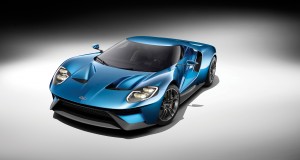The all-new 2016 Ford GT supercar will debut the Corning Gorilla Glass hybrid windscreen – a more durable, scratch-resistant window that is about 30 per cent lighter than traditional glass. Developed by Ford and Corning, the window will be used on both the windscreen and rear engine cover of the Ford GT, contributing to enhanced vehicle handling, improved fuel efficiency and reduced risk of glass damage.
“Gorilla Glass hybrid is a great example of how Ford works with suppliers to innovate in every area of our business,” said Hau Thai-Tang, Ford Global Purchasing group vice president. “Ford GT is setting new standards for innovation through performance and light-weighting, and we’re excited about exploring other applications for this great new technology.”
When tasked with developing lightweight and advanced material vehicle applications, the Ford team approached Corning, a leader in material science that introduced light and durable Gorilla Glass to the consumer electronic market in 2007. Interested in further exploring potential automotive applications, Ford engaged Corning to help research and develop a unique formulation for exterior vehicle glass.
Once the technology was studied for Ford’s supercar concept, the team realized there were real-world applications for the new hybrid glass. A small, dedicated group comprised of purchasing and engineering employees from Ford and Corning fast-tracked the technology to be introduced within four months.
“This successful collaboration is one of the reasons we spend research and development resources to develop new innovations and solve tough problems,” said Wendell Weeks, chief executive officer, Corning Incorporated. “Ford recognised the significant value of these innovative light-weighting technology and committed significant resources to quickly get it qualified for production applications. We worked with Ford to develop a glass that successfully withstood thousands of hours of durability testing and is now being used in a Ford production vehicle. We are excited to introduce this game changing technology to the market.”
Gorilla Glass hybrid
A traditional automotive laminated windscreen consists of two layers of toughened glass sandwiched around a clear, thermoplastic interlayer binding agent. Originally introduced in America by Henry Ford, the technology has been used in the auto industry for nearly a century.
The new hybrid glass uses a multilayer approach – a pane of toughened automotive-grade formed hybrid acts as the strengthened inner layer, an advanced noise-absorbing thermoplastic interlayer is in the centre, with toughened glass as the outer layer. The result is a windshield and rear engine cover approximately 32 per cent lighter than competitive vehicles.
“During development, we tried different glass variations before we found a combination that provided both weight savings and the durability needed for exterior automotive glass,” said Paul Linden, Ford body exteriors engineer. “We learned, somewhat counterintuitively, that the strengthened interior layer of the windscreen is key to the success of the hybrid window.”
The new Gorilla Glass hybrid window laminate is approximately 25 per cent to 50 per cent thinner, and has equal to, or greater strength than traditional laminate. Traditional laminate glass ranges from four millimetres to six millimetres in thickness, while Gorilla Glass hybrid window ranges from three to four millimetres. This remarkable reduction in thickness greatly reduces the weight of each panel.
The new technology was tested over stone and in rough road conditions, and had to endure specific projectile, rollover and wind tunnel testing.
“In addition to the new hybrid technology for the exterior glass of Ford GT, we’re using a unique glass combination for the bulkhead panel between passenger cell and engine bay,” said Linden. “We’re excited that we can use tailored glass applications to meet specific needs and provide maximum weight savings.”
The reduced weight of the windscreen, engine cover and bulkhead glass on Ford GT improves acceleration, fuel economy and braking performance. Perhaps most important is the benefit on handling – removing the weight of glass high in the construction of the vehicle lowers the center of gravity and contributes to the car’s outstanding agility.












Leave a Reply